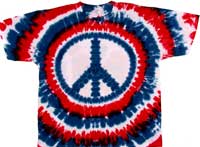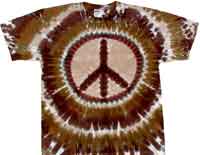History of Tie Dye

Tie dye is a popular fabric dyeing technique that has been around for centuries. It is known for its vibrant and colorful tie dye patterns and has been used to create unique and eye-catching clothing, accessories, and home decor. But where did this technique originate and how has it evolved over time? In this article, we will explore the rich history of tie dye and its significance in diverse cultures.
The Origins of Tie Dye

The earliest evidence of tie dye traces back to ancient civilizations such as Egypt, China, and India. These cultures used tie dye techniques to create intricate patterns on fabrics for clothing and decorative purposes. In Egypt, “tie dye” created the iconic "Tutankhamun's robe", a garment found in the tomb of the famous pharaoh. The robe featured a tie dye pattern of red, blue, and gold, and may have been created using a technique called "resist dyeing", where certain parts of the fabric are tied or covered to prevent the dye from reaching them. In China, tie dye was used to create beautiful silk garments for the wealthy. The technique was known as "zha ran" and involved tying and dyeing the fabric multiple times to create intricate patterns and designs. In India, tie dye was used to create the traditional fabric known as "bandhani". This fabric was used to make colorful turbans and saris and was created by tying small sections of the fabric with thread before dyeing it.
Tie Dye History in the West

Modern tie dye gained popularity in the Western world during the 1960s and 1970s, as part of the hippie and counterculture movements. The bright and bold patterns of tie dye were seen as a symbol of freedom and self-expression and were often worn as a form of protest against the traditional norms of society. During this time, tie dye was also associated with the psychedelic art and music scene and was often seen at music festivals and concerts. The Grateful Dead, a popular band from the 60s, even had their own line of tie dye merchandise that became iconic among their fans. Tie dye also became popular among the fashion industry, with designers such as Yves Saint Laurent and Halston incorporating the technique into their collections. It was no longer just a symbol of rebellion, but also a fashion statement.
The Evolution of Tie Dye
Over the years, tie dye has evolved and adapted to different cultures and trends. In the 1980s, it became popular in Japan as part of the "Harajuku" fashion trend, where bright and colorful tie dye clothing was paired with bold accessories and hairstyles. In the 1990s, tie dye made a comeback in the form of "grunge" fashion, with more muted and earthy tones being used in the patterns. It was also popular among the "hippie revival" trend, where tie dye was seen as a nostalgic symbol of the 60s and 70s.
Modern Tie Dye Techniques

Today, tie dye is still a popular technique used in fashion, home decor, and even art. With the rise of DIY culture and social media, tie dye has become more accessible and customizable than ever before. There are now various techniques and methods for creating tie dye patterns, such as the classic spiral, bullseye, and crumple techniques. There are also more advanced techniques like ice dyeing and shibori, a Japanese tie dye technique that involves folding, twisting, and binding the fabric before dyeing it. Tie dye has also expanded beyond just fabric and is seen on a variety of materials such as paper, wood, and even food. It has become a popular activity for people of all ages, with tie dye kits and workshops being readily available.
The Cultural Significance of Tie Dye

Tie dye has been used in various cultures throughout history, and each one has its own unique meaning and significance. In Japan, shibori tie dye was used to create traditional kimonos and was seen as a symbol of wealth and status. The intricate patterns and designs were often passed down through generations and were considered a form of art. In Africa, tie dye was used to create vibrant and colorful fabrics that were worn for special occasions and ceremonies. The patterns and colors used were often symbolic and represented different tribes and cultures. In the United States, tie dye has been used as a form of self-expression and rebellion, particularly during the civil rights and anti-war movements of the 1960s and 1970s. It has also been used as a symbol of unity and peace, with tie dye being a popular choice for protest and solidarity marches.
Tie Dye in Modern Culture
Today, retro tie dye is still seen as a symbol of self-expression and individuality. It has become a staple in music festivals, with tie dye clothing being a popular choice among attendees. It has also been embraced by celebrities and influencers, with many incorporating tie dye into their fashion and branding. Tie dye has also become a popular trend in home decor, with tie dye bedding, curtains, and even furniture being used to add a pop of color and personality to a space.
Conclusion
Tie dye has a long and vibrant history, and its popularity continues to evolve and adapt to different cultures and trends. From its origins in ancient civilizations to its rise in the Western world, tie dye has become a symbol of self-expression, rebellion, and unity. With its endless possibilities and colorful patterns, tie dye is sure to remain a beloved technique for years to come.
| All Time Favorites | ||||
 |
 |
 |
 |
 |


